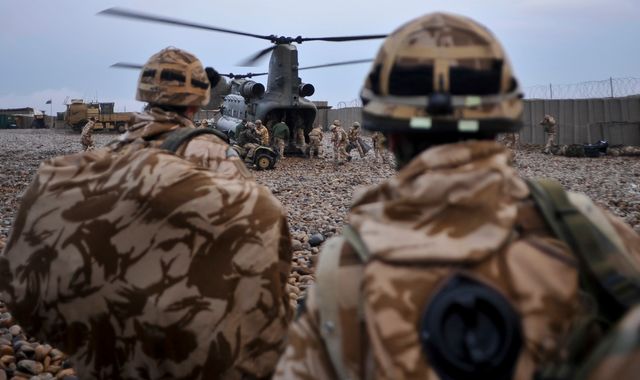
The UK will scrap five warships, dozens of military helicopters and a fleet of drones to save money despite growing threats from Russia and a war raging in Europe.
John Healey, the defence secretary, announced the dramatic move in parliament on Wednesday, saying it would save up to half a billion pounds over the next five years.
The defence secretary described the equipment being axed as “outdated” and said the “common sense” decision to retire them was long overdue.
Ukraine war latest: Follow live
He signalled the decision was part of a plan to restructure and modernise the armed forces, which have already been significantly reduced in size following decades of cost-saving cuts, with new capabilities due to come online to replace the gaps.
“We face increasing global threats,” Mr Healey said in a written statement that was released at the same time as he addressed MPs.
“War in Europe, growing Russian aggression, conflict in the Middle East and technology changing the nature of warfare. As a result, defence needs increased resilience and readiness for the future.”
At the same time, though, he said the defence budget faced “serious financial pressures”.
He repeated a pledge that the government would set out a course to lift the defence budget to 2.5% of national income – but yet again without giving a date.
The defence secretary then spelt out what “difficult decisions” meant in reality.
“To ensure that Britain is kept secure at home and strong abroad in a changing world, defence needs to make changes too. Difficult decisions are required,” he said.
The weapons systems on the chopping block are:
• The Royal Navy’s two amphibious assault ships, HMS Albion and HMS Bulwark. They will be taken out of service at the end of the year – around a decade early in a blow to the ability of the Royal Marines to launch land assaults from the sea.
• A fleet of 17 Royal Air Force Puma helicopters, as well as 14 of the military’s oldest Chinook helicopters
• A fleet of 46 Watchkeeper drones – each worth about £5m – barely six years since they entered into service
• HMS Northumberland, a Type 23 frigate, which is in need of costly repairs and has already operated well beyond an 18-year out-of-service date
• Two large Royal Fleet Auxiliary ships, RFA Wave Knight and RFA Wave Ruler – vessels which carry fuel and supplies to enable the Royal Navy’s aircraft carriers to operate around the world.
The announcement, while uncomfortable, is designed to be the least damaging way to reduce costs while retaining capability.
It comes ahead of a plan by the government to publish a sweeping new review of defence in the spring, which is being drawn up by an external team and is expected to recommend extensive changes across the army, Royal Navy and Royal Air Force.
The Ministry of Defence says that the equipment that is being axed – the term used is “accelerated retirement” – was selected because it is outdated and military chiefs need to focus finite money and personnel instead on the weapons systems most suited to modern warfare.
However, Russia’s war in Ukraine has demonstrated that old, outdated weapons are better than no weapons at all.
The Russian armed forces have relied heavily on old tanks, artillery guns and helicopters to fight after the weapons they used in the first weeks and months of the war were destroyed.
It takes years to build warships and helicopters.
Sir Keir Starmer will face uncomfortable challenges at the sight of amphibious assault vessels and Chinook transport helicopters being sold off or scrapped regardless of how old they are.
Yet it costs money to keep equipment in storage just in case it is needed.
Limited funds allocated to defence mean that military chiefs appear to have decided that scrapping weapons early is the least worst option.
The decision to scrap the British Army’s Mark 1 version of the Watchkeeper drone at a time when drones are such a dominant asset on the battlefield may also be tricky to defend.
However, the programme has been beset by delays, cost overruns and flaws.
The first Watchkeeper drones only started operating around 2018 – some eight years late.
They also struggle to operate in poor weather conditions – limiting their utility.
The rapid pace of evolving technology in drone warfare – where the development cycle is a mere six to eight weeks – means that the technology inside Watchkeeper, which was conceived of more than 14 years ago, may well be easily defeated in a fight.
It is understood that scrapping the aircraft means that the army will be able to focus money on developing new innovative drone capabilities.
EMEA Tribune is not involved in this news article, it is taken from our partners and or from the News Agencies. Copyright and Credit go to the News Agencies, email news@emeatribune.com Follow our WhatsApp verified Channel





